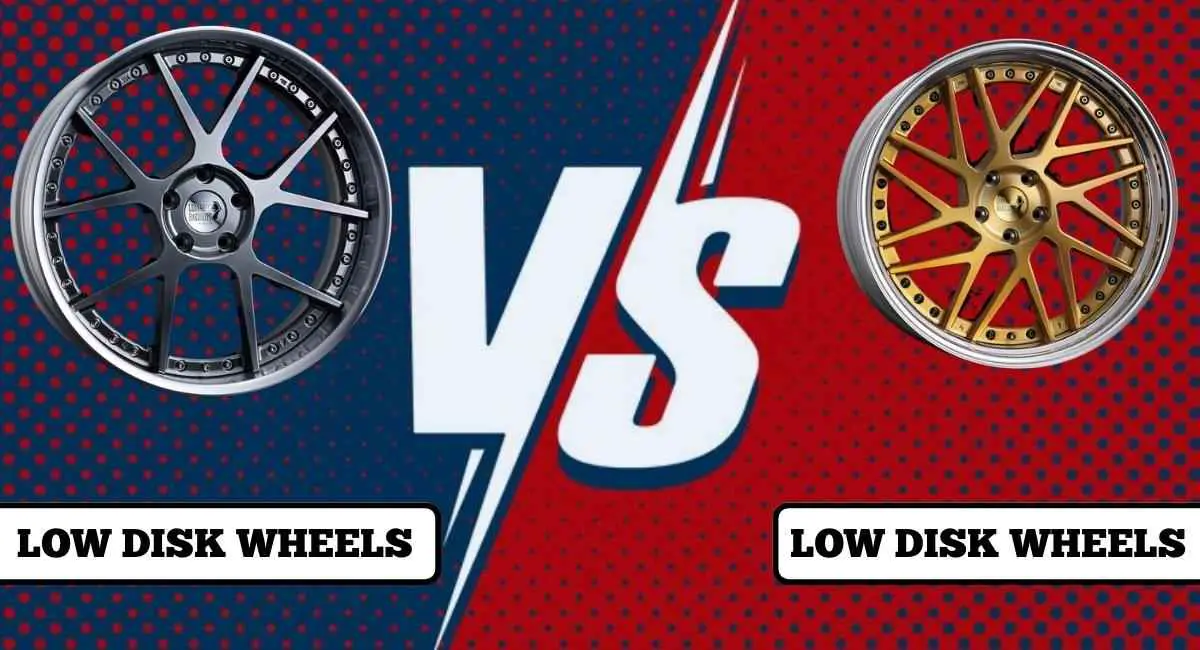In the world of automotive enthusiasts, details are everything. Each component is scrutinized, from the powerhouse engine under the hood to the sleek exteriors, for maximum performance and aesthetic appeal. However, amidst this myriad of parts and technical specifications, one feature that often flies under the radar yet significantly influences your driving experience is the wheel disk type.
Choosing between high-disk and low disk wheels can drastically alter your vehicle’s handling, performance, speed, and overall aesthetics. High disk wheels, with their deeper and wider profile, offer improved traction and stability, making them a popular choice for high-speed drivers and those seeking a more aggressive aesthetic.
In contrast, low disk wheels, characterized by their shallower and narrower profile, offer quicker acceleration, easier maneuverability, and a sleeker look, making them suitable for city drivers and those valuing efficiency and agility.
This comprehensive guide explores the intricacies of low disk vs. high-disk wheels, their unique characteristics, advantages, and how to choose the best type based on your driving needs.
Understanding Wheel Disk Types in Cars
Understanding car wheel disk types is critical in optimizing your vehicle’s performance, handling, and fuel efficiency. The wheel disk, often called the rim, is the wheel’s outer edge that holds the tire. This component plays a key role in determining how your car interacts with the road, influencing everything from acceleration to braking.
There are variant wheel disk types, but two primary types of wheel disks are widely recognized in the automotive world: high-disk and low disk wheels. Each type boasts unique characteristics and advantages, and their suitability largely depends on the demands of your driving conditions and personal preferences. But before looking into low-disk vs. high-disk wheels, let’s check out other wheel disk types.
Super High Disk (SHI-disk)
SHI-disk, or Super High Disk, features the most substantial brake clearance among other disk types, although it possesses a minimal rim lip size.
Cars fitted with Big Brake Kits, such as Brembo or Akebono, often need SHI-disk wheels to accommodate the large brake calipers. Examples of such vehicles include the Evo 8-10, Infiniti G37, Nissan 370Z, and Subaru STi.
Super Low Disk (SLO-disk)
The SLO disk, or Super Low Disk, offers the maximum possible lip size, contributing to a great rim effect.
It’s often the top choice for those desiring a pronounced lip. However, it provides less clearance than the HI disk, typically by about 30mm.
The High Disk Wheels
High disk wheels, also known as deep-dish wheels or HI disks, are characterized by their deeper and wider rim profile. This structure provides a larger surface area that interacts with the road, impacting several aspects of the car’s performance.
The HI disk provides less clearance than the SHI disk, typically by about 10mm.
The disk works on certain cars that have upgraded big brake kits and don’t necessarily require the clearance provided by SHI-disk.
The most significant advantage of high-disk wheels is their potential for enhanced stability. The increased wheel mass due to the larger disk surface offers better traction, which can be beneficial during high-speed drives or wet conditions. In terms of aesthetics, high disk wheels also provide a distinctive, aggressive look, often favored in car modification for their bold appeal.
High-disk wheels have drawbacks. Their larger size can strain the vehicle’s suspension and braking systems. It can make the car feel heavier and slower in acceleration. They are also prone to damage from potholes and curbs.
Examination of the Low Disk Wheels
Contrastingly, low disk wheels feature a shallower and narrower rim profile, resulting in a lighter wheel. This design lends itself well to several benefits in performance and handling.
The Low Disk wheels or LO-disk is the most commonly chosen disk type, as it provides adequate clearance for most OEM factory front and rear brakes that don’t employ a Big Brake Kit (BBK). This standard disk typically provides 17mm less support than the HI disk.
The lighter weight of low-disk wheels allows for quicker acceleration and easier maneuverability, making them ideal for city driving or situations that require frequent stopping and starting. Their smaller size makes them less prone to damage from road hazards like potholes, and they often offer improved fuel efficiency due to reduced rolling resistance.
However, low-disk wheels may provide different traction and stability than high-disk wheels, especially at higher speeds or in challenging driving conditions. Aesthetically, while many appreciate the sleek look of low disk wheels, they might need more bold visual impact that high disk wheels bring to a vehicle.

Comparative Analysis: Low Disk vs High Disk Wheels
The distinction between low-disk and high-disk wheels is one of the pivotal factors that can influence a vehicle’s performance, handling, and overall driving experience. Each type has unique characteristics, benefits, and potential drawbacks that make it more suitable for certain driving conditions and styles. In this section, we’ll delve into a comparative analysis of these two-wheel disk types, helping you understand their different aspects and making an informed choice based on your needs.
Wheel Height
Low-disk wheels typically have a smaller height than high-disk wheels. It results in a more compact look and feel, which might be preferred by those aiming for a sleek, sporty aesthetic. On the other hand, high disk wheels are usually taller, providing a more aggressive and robust appearance that’s often associated with performance or off-road vehicles.
Ground Clearance
With their smaller height, low disk wheels tend to lower the vehicle’s ground clearance. It can be advantageous for enhancing handling and stability at higher speeds, but it might present challenges when traversing rough or uneven terrains. High disk wheels, in contrast, offer higher ground clearance, which can be beneficial for off-road driving or navigating over obstacles.
Center of Gravity
Both low and high-disk wheels maintain a lower center of gravity. This factor is crucial as it improves stability and handling, especially when taking corners.
Maneuverability
When it comes to agility and skill, low-disk wheels take the lead. Their smaller size and lighter weight contribute to improved responsiveness, making them suitable for city driving or situations requiring frequent changes in speed or direction. High-disk wheels, however, may offer less agility due to their larger size.
Stability
Despite their greater maneuverability, low-disk wheels may provide a different level of stability than high-disk wheels, especially at higher speeds or in challenging driving conditions. High-disk wheels generally deliver better stability with their larger contact area with the road.
Shock Absorption
Regarding shock absorption, high-disk wheels tend to outperform their low-disk counterparts. Their larger size allows for better distribution of shocks from road bumps or potholes, offering a smoother ride. Conversely, low-disk wheels may not absorb shocks as effectively.
Rolling Resistance
Low-disk wheels often have higher rolling resistance, which can impact fuel efficiency. On the flip side, with their larger diameter, high disk wheels typically provide lower rolling resistance, which can contribute to better fuel economy.
Weight
Low-disk wheels are generally lighter than high-disk wheels. This reduced weight can contribute to quicker acceleration and improved fuel efficiency. In contrast, high-disk wheels are often heavier due to their larger size.
Durability
Regarding durability, high disk wheels are more robust and long-lasting, thanks to their thicker and sturdier construction. Low-disk wheels, however, might be less durable due to their smaller and more lightweight design.
Aesthetics
Low-disk wheels offer a sleek and compact appearance, appealing to drivers seeking a sportier or more streamlined look. While some drivers prefer the aggressive look of high-disk wheels, they might be less appealing to those seeking a sleeker, more understated aesthetic.
Brake Clearance
High-disk wheels offer better brake clearance, which is an essential factor if you’re planning to install larger brakes or drive a high-performance car. Low disk wheels, while providing less clearance, may be suitable if your vehicle has standard-sized brakes and doesn’t require high-performance braking.
In summary, you should base the choice between low-disk and high-disk wheels on your driving style, the conditions you typically drive in, and your personal preferences. Understanding the differences between these wheel types is crucial to enhance your vehicle’s performance and overall driving experience.
Making the Right Choice: Factors to Consider when Choosing Wheel Disk Type
Choosing between high-disk and low disk wheels is paramount. Your driving style and needs are critical. High-disk wheels might be the best choice if prioritizing speed and stability. However, low-disk wheels may be better if city driving, quick acceleration, and fuel efficiency are your priorities.
Secondly, the terrain and environmental conditions you drive in regularly should influence your decision. High-disk wheels can perform better in wet or challenging situations, while low-disk wheels suffice for regular city driving.
Important Read: Why Your Vehicle Has the Blue-Tinted Rearview Mirror
Lastly, consider maintenance and cost. High-disk wheels can be more expensive and may incur higher maintenance costs due to potential damage from road hazards. Low-disk wheels are generally more budget-friendly and less prone to damage.
Conclusion
In the world of automotive wheels, understanding the nuances of wheel disk types can significantly enhance your driving experience. Whether you opt for low-disk or high-disk wheels, you must consider your driving style, environmental conditions, and personal preferences. This comprehensive guide aims to equip you with the knowledge to make an informed decision, ensuring an optimized and enjoyable driving experience. And remember, it’s always wise to consult with a professional when making significant changes to your vehicle. Happy driving!
